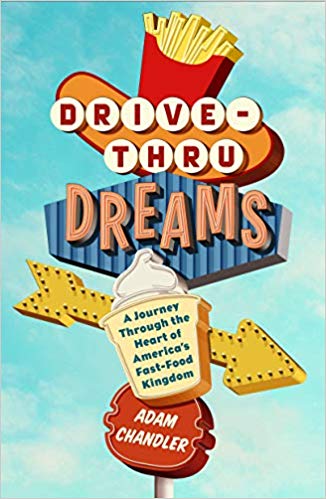You have /5 articles left.
Sign up for a free account or log in.
 Drive-Thru Dreams: A Journey Through the Heart of America's Fast-Food Kingdom by Adam Chandler
Drive-Thru Dreams: A Journey Through the Heart of America's Fast-Food Kingdom by Adam Chandler
Published in June 2019
When was the last time that you ate at a fast food restaurant? Where did you visit? Who did you go with? What caused you to go?
My answers to these questions are: May 2019. McDonald's in Tokyo. Three generations of the Kim family. Craving hamburger and cheese.
It took going 6,593 miles away from home to tempt me back to a fast food restaurant.
For many years now, my family -- led by my kids -- has been on something of an anti-fast-food kick. The 2004 release of Super Size Me, and the 2006 Michael Pollan book The Omnivore's Dilemma, somehow turned my family against the joys of McNuggets and Big Macs.
In Drive-Thru Dreams, Adam Chandler does not shy away from the many downsides of the fast food-industrial complex. These harms include the damage that Americans do their health by overeating fried, salty and sweet fast food. There is also the issue of the low wages, nonexistent benefits and irregular shifts endured by the fast food labor market.
Drive-Thru Dreams, however, is not at all a polemic against the fast food industry. Chandler exhibits real affection for America's quick dining establishments. The author sees McDonald's and Burger King and KFC and Wendy's and Taco Bell as not only places to get a cheap (if likely unhealthy) meal, but as one of the few class-leveling institutions still standing in our increasingly economically segregated society.
For Chandler, a Whataburger (his favorite Texas-based burger chain), and all other low-priced counter service restaurants, is a place where everyone is still welcome. McDonald's function as makeshift community gathering spots for those not in the paid labor market (the elderly, teenagers, stay-at-home parents) as much as factories for food production and consumption.
Where Drive-Thru Dreams shines brightest is in tracing the origins of America's fast food obsession. We learn about White Castle, the original fast burger joint that first came to life in Wichita, Kans., in 1916. Chapters on the origins of Kentucky Fried Chicken, McDonald's and Burger King set the story in historical context. The book's analysis of the shifting market for quick-service meals, and the economics of the food industry labor market, nicely fill out the story of fast food.
While reading Drive-Thru Dreams, my mind kept wandering to the undercurrent of worry among academics that higher education is at risk of McDonaldization. Actually, I'm not sure if we higher ed people use fast food as a metaphor to express our fears, but the comparison seems to fit.
We worry that a standardized, cheap and industrial-size higher education will be as unhealthy for students as a diet of only Egg McMuffins and Taco Bell burritos. We will do whatever it takes to resist turning the higher ed workforce into the equivalent of a low-wage McDonald's crew. Although the adjunctification of the faculty suggests that we may have already lost that fight.
What Drive-Thru Dreams made me wonder is if there exists -- and I don't know there does -- a positive model in the fast food ecosystem for our own?
Is there any case, any case at all, to be made for a standardized, commoditized and inexpensive postsecondary option?
Is the McDonaldization of higher education already happening in the shape of comparatively low-cost online degree programs, nondegree alternative credentials or educational platforms built on the principles of scale?
As we learn in Drive-Thru Dreams, between 60 to 70 percent of all fast food sales occur through the drive-through. Is online education at scale the future drive-through of higher ed?
If there is a good fast food, Chandler seems a fan of In-N-Out burger. Is there a good cheap (and convenient) higher ed?
What books on the American way of eating would you recommend?
What are you reading?




